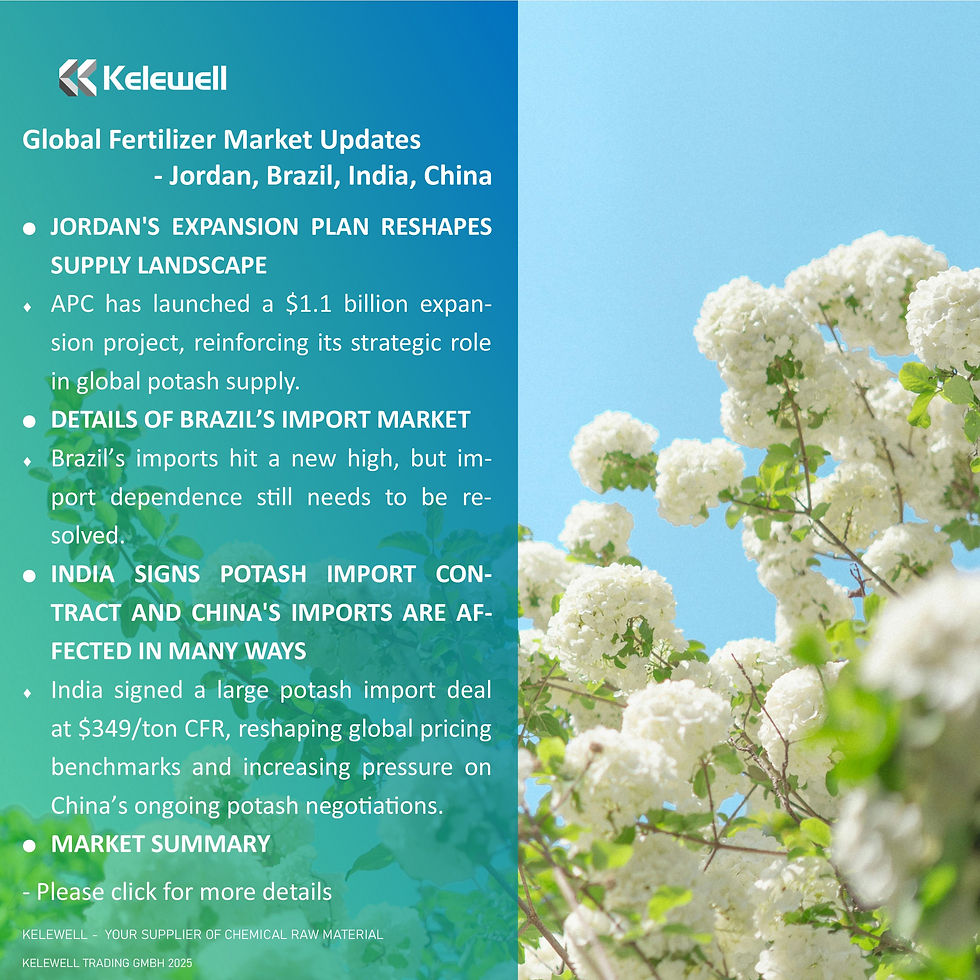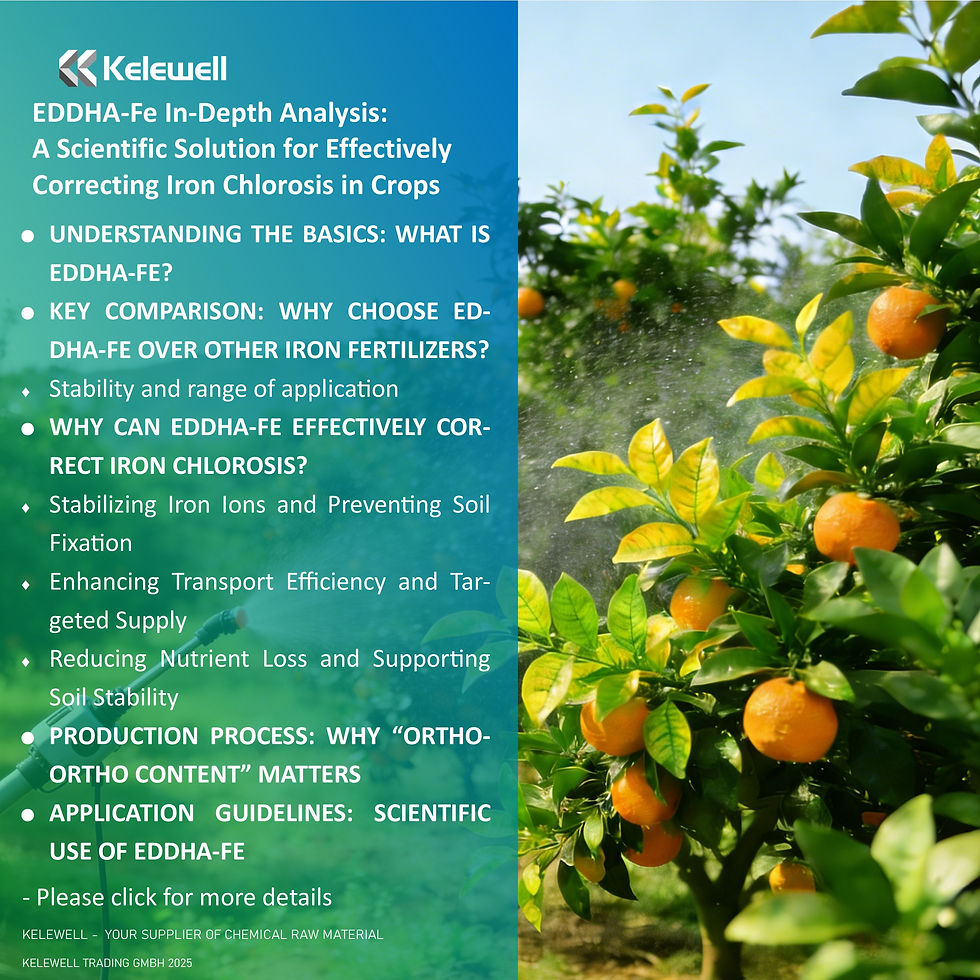Global Fertilizer Market Update:Jordan Launches Expansion, Brazil's Imports Surge, and India’s potash import contract Pressures China’s Import Strategy
- Fernando Chen

- Jun 9
- 4 min read
Jordan’s Arab Potash Company Launches Southern Expansion Project: Annual Capacity to Increase by 740,000 Tons
In response to the shifting global supply and demand dynamics in the potash market, Jordan’s Arab Potash Company (APC) officially launched its Southern Expansion Project on May 21, 2025. The project was inaugurated by Jordanian Prime Minister Jafar Hassan.
Currently, APC has an annual production capacity of approximately 2.96 million tons. As the sole potash-producing enterprise in Jordan, its production facilities are located at the southern end of the Dead Sea. The company exports mainly to China, India, Malaysia, and other countries.
With an estimated investment of USD 1.1 billion, the project aims to increase the company’s annual potash output by 740,000 tons, bringing total capacity to 3.7 million tons. Initial construction is scheduled to begin in the second half of this year, with completion expected by 2029. The project includes the construction of new evaporation ponds, a potash processing plant, and granulation facilities, all supported by the adoption of advanced technologies to optimize production processes.
The Prime Minister emphasized that this initiative, alongside other major national strategic projects such as the Red Sea desalination plant and the Aqaba railway, constitutes a key component of Jordan’s future development agenda.
Brazil's Fertilizer Imports Hit Five-Year High in First Four Months of 2025, Up 13% Year-on-Year
According to Brazil’s official logistics bulletin, the country imported 11.54 million tons of fertilizers between January and April 2025, marking a 13% year-on-year increase and the highest volume for the period since 2021. The surge was driven by procurement for winter crops and expectations of a strong upcoming harvest.
In February, imports reached 2.33 million tons (up 21% YoY).
In April, imports totaled 3.63 million tons (up 20% YoY).
In comparison, total fertilizer imports in 2024 amounted to 44.3 million tons. Historically, Brazil’s fertilizer imports tend to peak in the second half of the year, but the volume recorded in the first four months of 2025 already surpasses typical early-year levels.
The Brazilian government is currently implementing the National Fertilizer Plan, which aims to reduce the country's import dependency from 85% to 50% by 2050. As part of this initiative:
Petrobras will reopen a fertilizer plant in the southern state of Paraná in June 2025.
Mosaic has announced plans to build a new blending plant in northern Brazil.
Port Import Statistics:
Paranaguá Port leads with 3.03 million tons of fertilizer imports (up 21.68% YoY), followed by northern ports with 2.52 million tons (up 13.51%).
Santos Port saw a decline of 12.57%, down to 1.6 million tons.
As of May 29, market quotations indicate:
Granular urea CFR Brazil: $380/ton
Monoammonium phosphate (MAP), bulk CFR Brazil: $726/ton
Indian Potash Fertilizer Contract Price Settlement and Multi-Dimensional Impact on China's Potash Fertilizer Imports
Between June 4 and 6, Belarus and Russia respectively signed potash supply contracts with India at a CFR price of $349/ton, totaling 1.25 million tons to be delivered by the end of December 2025. The contract price reflects a 25% year-on-year increase, reshaping the global potash pricing landscape and exerting direct influence on China’s import dynamics.
As the fourth-largest potash importer globally, India’s contracted volume accounts for approximately 35% of its total imports in 2024, underscoring the pricing power and export dominance of Belarus and Russia. In the first quarter of 2025, combined production from Russia and Belarus declined by 1.2 million tons. With persistently high prices in Brazil and Southeast Asia and India’s port inventory falling to just 170,000 tons ahead of its planting season, India had little leverage and was compelled to accept the contract price.
China and India have historically maintained similar benchmark potash contract prices, making this Indian deal a key reference point for the Chinese market. However, China’s negotiating delegation has yet to respond publicly, and the market is closely watching whether China will align with India’s contract price.
Multi-Dimensional Impacts on China’s Potash Imports:
Increased International Pricing Pressure:
India’s acceptance of a high-price contract eases pressure on global suppliers, making short-term price concessions to China less likely.
Domestic Price Pressure Amid Weak Demand:
In China, domestic potash prices have surged while grain prices remain weak, reducing farmers' enthusiasm for planting. With potash prices at historic highs, demand in 2025 may face downward pressure.
China’s Strategic Advantages:
Reasonable port inventories and off-season flexibility allows China to wait strategically.
Diverse import channels: In addition to sea shipments, China can source potash via land routes from Russia, Belarus, Laos, and Uzbekistan.
Deeper geopolitical cooperation: China’s supply chain stability is more robust compared to India.
At present, the market is in a phase of information gathering and strategic adjustment. The final price and signing timeline of China's next major potash import contract will reflect a three-way negotiation among international supplier strategies, China’s ability to diversify sourcing, and seasonal domestic demand trends. Continued attention to key timing and market data updates is essential.
Conclusion: A New Global Potash Order Amid Structural Shifts and Pricing Power Struggles
By mid-2025, the global potash market is undergoing a critical phase of restructuring, marked by simultaneous adjustments in supply, demand, and pricing strategies.
On the supply side, Jordan's Arab Potash Company has officially launched its Southern Expansion Project, aiming to raise its annual capacity to 3.7 million tons by 2029—highlighting the Middle East's growing strategic role in global potash production.
On the demand side, Brazil’s fertilizer imports surged by 13% year-on-year in the first four months of 2025, reaching a five-year high. This underscores the country’s continued heavy reliance on potash and its accelerating efforts to localize production and ensure supply security through national initiatives.
In terms of pricing, India’s recent long-term contract with Russia and Belarus at a high CFR price of $349/ton has established a new international benchmark. This has triggered ripple effects across the market, directly influencing the pace of China’s negotiations, its procurement strategies, and broader price expectations.
Amid diverging demand trends, redefined pricing dynamics, and shifting supply structures, the global potash market is entering a more strategic and uncertain phase. Future competitiveness will depend on a nation's ability to diversify sourcing channels, strengthen negotiating leverage, and adapt effectively to policy and market shifts.




Comments